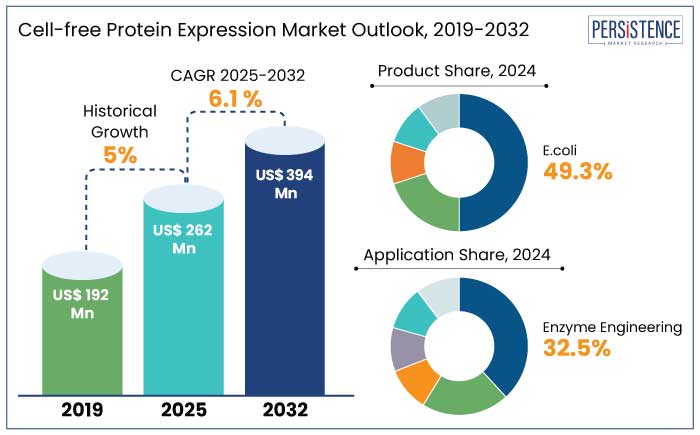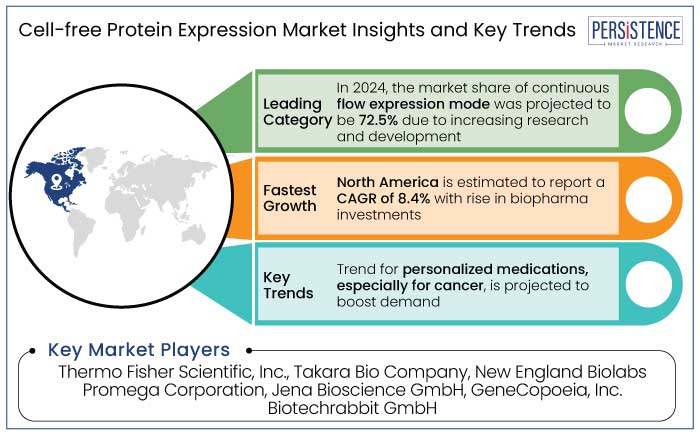Industry: Healthcare
Published Date: January-2025
Format: PPT*, PDF, EXCEL
Delivery Timelines: Contact Sales
Number of Pages: 186
Report ID: PMRREP12385
The global cell-free protein expression market is estimated to reach a size of US$ 262 Mn in 2025. It is predicted to rise at a CAGR of 6.1% through the assessment period to attain a value of US$ 394 Mn by 2032.
Protein manufacturing is undergoing a revolution because of cell-free expression technologies, which provide sophisticated molecular targeting, reduced costs, and shorter production times. Cell lysates are utilized in these systems for transcription and translation. These are further facilitating the synthesis of biologics like toxic proteins, membrane proteins, and post-translationally modified proteins.
In August 2023, for example, Enzymit, an innovative bioproduction company from Israel, successfully utilized cell-free technology to produce cost-efficient enzymes, addressing critical industry needs. Demand for biologics continues to rise, with the global biologics market projected to surpass US$ 477 Bn by 2025, according to industry reports. Key players in the biopharmaceutical sector are investing heavily in research and development to optimize cell-free expression systems, a shift beyond protein manufacturing.

Key Highlights of the Market
|
Market Attributes |
Key Insights |
|
Cell-free Protein Expression Market Size (2025E) |
US$ 262 Mn |
|
Projected Market Value (2032F) |
US$ 394 Mn |
|
Global Market Growth Rate (CAGR 2025 to 2032) |
6.1% |
|
Historical Market Growth Rate (CAGR 2019 to 2023) |
5% |
In 2024, North America generated a 58% market share globally due to technical breakthroughs in biopharmaceuticals and substantial expenditures in research and development. These are supported by the rising need for scalable, effective processes. For instance,
The benefits of cell-free systems are projected to propel demand for cell-free protein expression to a CAGR of 8.4% between 2024 and 2032 in North America. A few features include their scalability, capacity to create complex proteins, and quick production times Microbial cell-free expression system is likely to dominate the industry in the U.S., with widespread adoption in drug development, enzyme production, and synthetic biology.
Asia Pacific cell-free protein expression market is projected to register a CAGR of 5.13% through 2032, fueled by rising biotechnology developments and strategic partnerships. The region is also predicted to be driven by increasing demand for efficient protein production methods in biopharmaceuticals, personalized medicine, and synthetic biology, accounting for 27.5% of the market.
Countries like China, India, and Japan are embracing cell-free systems to meet the demand for complex protein production. For example,
E. coli cell-free protein expression systems dominate the market due to cost-effectiveness, high protein yields, and versatility. The segment held a 49.3% market share in 2024, driven by recombinant technology developments and biologic therapeutic demand. E. coli lysates are extensively utilized in the production of insulin, enzymes, and vaccines due to their scalability and ease of use. For instance,
Innovations in the healthcare sector shifted their focus to reducing endotoxin contamination, thereby broadening their appeal in pharmaceutical applications. E. coli cell-free systems are essential for biopharmaceutical research, especially in creating quick and affordable protein production options. They are set to be worth over US$ 120 Mn worldwide in 2024.
A leading method in cell-free protein expression is the continuous flow expression mode, which permits constant protein synthesis and high-yield production. It is especially evident in the manufacturing of therapeutic proteins and enzymes.
In 2024, the continuous flow expression mode accounted for 72.5% of the market share, reflecting its rising adoption in biopharmaceutical research and industrial applications. For instance,
Companies like Arbor Biosciences and GeneFrontier Corporation are enhancing cell-free protein synthesis by integrating automation and microfluidics, improving scalability, and reducing operational costs.
Growing need for effective protein synthesis in pharmaceutical and biotechnology research drives expansion in the global cell-free protein expression market. As drug development processes demand rapid protein synthesis and characterization, cell-free systems offer faster and cost-effective alternatives to traditional cell-based methods. For example,
Applications in personalized medicine, particularly in rapid protein production for diagnostics and therapeutics, propel market expansion. Innovations in synthetic biology and protein design are enhancing the flexibility and scalability of cell-free expression platforms, making these indispensable for producing vaccines and therapeutic proteins.

The global cell-free protein expression market recorded a CAGR of 5% in the historical period from 2019 to 2023. The healthcare sector is among the several industries that have been impacted by the COVID-19 epidemic. In order to create novel instruments, vaccines, and therapies for COVID-19 patients, researchers resorted to synthetic biology, namely cell-free protein expression systems.
The market has benefited as a result, and cell-free protein expression is now widely employed for a variety of therapies. To quickly detect SARS-CoV-2 antibodies, for instance, Northwestern University created a high-throughput, cell-free automated screening device.
PPD, Inc. was purchased by Thermo Fisher Scientific for US$ 17.4 Bn in 2021, while Fluorogenics Limited was purchased by New England Biolabs. Demand for cell-free protein expression is estimated to record a CAGR of 6.1% during the forecast period between 2025 and 2032.
Rising Demand for Efficient Protein Production in Pharmaceutical and Biotech Research
Demand for efficient protein production methods is on the rise in pharmaceutical and biotechnology research due to the need for rapid and cost-effective production of biologics, vaccines, and therapeutic proteins. For instance,
Rising demand for biologics in personalized medicine further accelerates the adoption of high-throughput protein production methods.
Trend for Personalized Medicine Presents Growth Prospects in Protein Production
The field of personalized medicine is growing with developments in protein production and analysis technologies. Rising need for individualized therapies is set to propel demand for customized medicines to 10.3% year-on-year, reaching US$ 740.4 Bn in 2024.
Leading the way in cell-free protein expression systems are GenScript and Aequor, which facilitate the quick and effective synthesis of therapeutic proteins for individualized treatment. It is further accelerating drug discovery and improving the accuracy of biological medications and vaccines. The healthcare industry is set to experience a 15% increase in the use of cell-free systems for therapeutic protein production in 2024, paving the way for personalized treatments.
Difficulty in Performing Humanized Glycosylation Patterns Limits Adoption
Lack of eukaryotic co- and post-translational modifications is impeding growth of the cell-free protein expression business, which can result in high costs and low protein yield. Glycosylated proteins can be expensive and challenging to use in industrial-level humanized research and development investigations.
They cannot be produced by cost-effective cell-free systems like E. coli. Furthermore, because of their short reaction times and expensive reagents, cell-free methods are impractical for large-scale protein production. Protein folding capabilities may be restricted as a result, and the use of these systems in humanized research and development at the industrial level may be complicated.
Applications in Structural Biology and Protein Engineering Require Rapid Expression
Demand for cell-free protein expression systems is increasing due to their crucial role in structural biology and protein engineering. These are enabling efficient protein production and facilitating the study of protein structure, dynamics, and function.
Rapid protein synthesis capabilities significantly enhance structural biology applications like X-ray crystallography and cryo-electron microscopy, aiding researchers in comprehending intricate biological mechanisms. For instance,
Cell-free systems are increasingly being utilized in life sciences due to their ability to produce toxic or unstable proteins, accelerating research timelines.
High-throughput Protein Production Presents Avenues for Research and Development
Demand for high-throughput protein production systems is boosting research and development activities in biotechnology and pharmaceuticals. For example,
Complex enzymes, including those with post-translational changes, can be synthesized using cell-free protein expression platforms, facilitating accurate functional analyses and commercial biocatalysis applications. The market benefits from investments in personalized medicine and synthetic biology, increasing demand for these versatile expression platforms.
Leading manufacturers in the global cell-free protein synthesis market are actively working to enhance demand for their products and broaden their presence across various countries. These industry players are concentrating their efforts on obtaining FDA approval for their therapeutic solutions, which is a crucial step in ensuring safety and efficacy.
Market players are seeking to establish collaborative partnerships with local distribution networks, which will not only facilitate easier access to their products but also boost their market share and revenue. This strategic approach underscores their commitment to combatting the common fungal infection effectively while extending their influence within the global healthcare landscape.
Recent Industry Developments
|
Attributes |
Details |
|
Forecast Period |
2025 to 2032 |
|
Historical Data Available for |
2019 to 2023 |
|
Market Analysis |
US$ Billion for Value |
|
Key Regions Covered |
|
|
Key Market Segments Covered |
|
|
Key Companies Profiled in the Report |
|
|
Report Coverage |
|
|
Customization and Pricing |
Available upon request |
By Product
By Application
By Expression Mode
By End User
By Region
To know more about delivery timeline for this report Contact Sales

The market size is set to reach US$ 394 Mn by 2032.
Cell-free Protein Synthesis (CFPS) is a groundbreaking technology that offers advantages including protein expression, metabolic engineering, therapeutic development, and education.
In 2024, North America generated a market share of 58%.
In 2025, the market is estimated to be valued at US$ 262 Mn.
Thermo Fisher Scientific, Inc., Takara Bio Company, New England Biolabs, and Promega Corporation are a few key players.